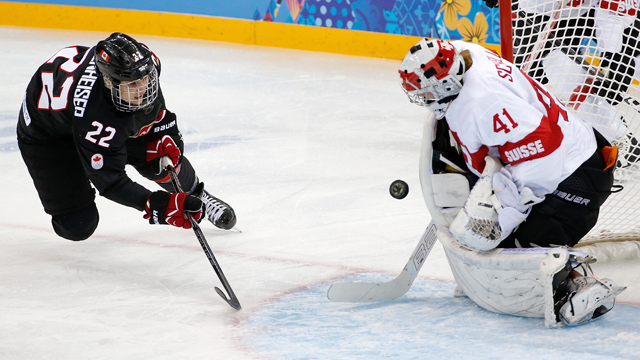SOCHI, Russia – Kevin Dineen had predicted there would not be an easy game for his Canadian team at these Olympics and it would be hard to label the opener difficult.
Still, it’s important to step back and look at the big picture before launching into any debate about the current status of the women’s game. That, of course, is a part of the quadrennial tournament that you can basically set your watch to – this being the “two weeks out of every four years,” in the words of Hayley Wickenheiser, when the sport is put under the microscope.
Based on what we saw in the opening two games at Shayba Arena on Saturday, there was actually reason to feel encouraged. That conclusion may surprise you if you were only to look at that boxscore, with Canada outshooting Switzerland 64-14 in a 5-0 victory and the U.S. outshooting Finland 43-15 while winning 3-1.
However, there is more to consider than that. Remember that four years ago these two matchups produced even more lopsided results with the Canadians hammering the Swiss 10-1 at the Vancouver Games and the U.S. blanking the Finns 6-0.
Beyond that, it’s useful to examine aspects of Saturday’s games rather than just the entire picture. Finland put on a push in the final 20 minutes after having the ice tilted against it early – a pattern the Swiss managed to replicate in the evening game. They actually generated some decent scoring opportunities against Canadian goalie Charline Labonte before the final buzzer.
“It was just good for us the last seven or so minutes,” said Swiss goalie Florence Schelling, who was outstanding in the loss. “We were pressuring them and they had a hard time breaking out and it shows us that we actually have improved. Playing the third period 0-0 – usually we break down in the third period because we’re tired and we can’t keep up with them.
“Today it wasn’t the case. We pushed even harder at the very end.”
These are morale victories, to be sure, but they could be important ones if you are willing to take the long view. That is an increasingly difficult thing to do in the modern world, where patience is in short supply.
However, the Olympic organizers have done what they can to speed things up with a format change for this event. The U.S., Canada, Finland and Switzerland have all been lumped together in a strong group playing for three playoff positions while Russia, Sweden, Japan and Germany battle for the other one. It simply makes sense.
That should at least keep us from seeing scores like 18-0, 13-1, 13-0 and 12-1 as we did in Vancouver. Those results prompted former IOC President Jacques Rogge to muse about the possibility of removing women’s hockey from the Olympics – a threat that sent a shockwave through the sport.
For now, that talk seems to have died down, which is a good thing if you look at the overall quality of the games. The women are noticeably faster and stronger than they were four years ago. The shots really zip off their sticks.
“So much better,” said Finnish goalie Noora Raty. “I’ve been practising with the men (in the Finnish second division) the whole year. (The shots) are not as hard as theirs, but they’re definitely getting harder.”
This is also just the fifth ever Games where women have been allowed to participate. Raty had to play with boys throughout minor hockey – her first all-female team came in NCAA with the Minnesota Golden Gophers – and without question the sport has become more accessible for young girls since then. The Swiss roster that faced Canada included 15-year-old forward Aline Muller, whose baby face was unmistakable as the players spoke with reporters afterwards.
These are all signs of a sport that is in its infancy, just as men’s hockey once was almost 100 years ago. There will continue to be challenges, including the fact that Canada and the U.S. are likely to continue improving along with all of the countries chasing them, but that doesn’t mean the gap won’t eventually shrink.
“We are so much further ahead in this time span than if you look at say the history of where men’s hockey was at this time (in its development),” said Wickenheiser. “I think the game has really come a long way in the Olympics that we’ve seen.”
The games on Saturday provided evidence of that. Schelling made some phenomenal saves, including a point-blank chance from Marie-Philip Poulin after a 3-on-1, and teammate Phoebe Stanz had her moments on the forecheck against Canada. There were strong hockey plays being made.
Another benefit of the new Olympic format is that it guarantees an early Canada-U.S. meeting – they close out the round robin with a can’t-miss game Wednesday – and that will bring some extra intrigue to the tournament. There is already talk about whether either team will hold back tactics or disguise strategy in case they end up meeting again for a medal.
“My feeling on that is that our group is prepared,” said Dineen. “If you want to know what we’re doing – you know what? This is what we do, try to stop us.”
In reality, there’s still basically only one team right now that can. But that doesn’t mean it will remain that way forevermore.


